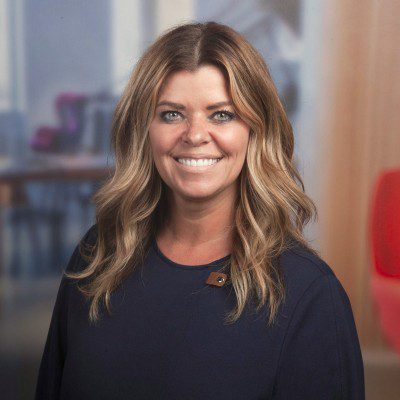Could EY and IBM’s new COE transform the HR tech space?
Let’s take a look inside their new talent-focused partnership.
Why You Should Care
IBM and EY are two giants of the tech and professional services sectors.
Now they are teaming up to provide employers with joint offerings that will aim to transform the world of HR.
Here's the inside track from interviews at UNLEASH America 2022.
In the middle of May, professional services giant Ernst & Young (EY) teamed up with tech corporation IBM to launch a center of excellence (COE) specifically to support financial services businesses to succeed in their digital transformation.
The aim of the financial COE was “really about EY being able to bring IBM tech to their financial services” offerings, IBM Consulting’s talent transformation partner Andy Jankowski shares exclusively at UNLEASH America 2022. Jankowski is the global leader of the EY and IBM talent alliance.
But IBM and EY decided that they didn’t want to stop there, so they moved to further expand the EY-IBM alliance with a second COE focused on the talent space.
The talent COE aims to help employers address significant workplace challenges that have cropped up following the COVID-19 pandemic – such as digital adoption, retention and attraction of talent, as well as upskilling to address skills gaps.

Susan Robinson, global technology, media and telecommunications (TMT) people advisory services leader, EY.
Jankowski notes: “The reason we created this COE is to look across all the different offerings that we have and bring all of our strengths together”.
Susan Robinson, EY global technology, media and entertainment people advisory services leader, adds: “We are both really established, mature business in the talent space with strong value propositions and strong client relationships”.
By joining forces, the COE can “upset” the market – “we certainly want to make a splash from a market share perspective” and achieve “world domination”.
But EY and IBM also want to have “an impact in transforming that talent space and making their lives easier”.
Shortcutting the multi-vendor model
Ultimately, for IBM and EY, this is about ensuring that they can provide their clients with top-class solutions for their multi-faceted talent needs.
Jankowski tells UNLEASH that the hope is that the talent COE means companies no longer have to choose the second best offering for their HR needs, instead they would be able to choose “a group that was best” in every area.
“We’re taking compromise out of the occasion. We’re partnering to ensure they can have the best”, adds Jankowski.
He continues that when IBM talks to its customers, “we know what the clients are asking for”, “we know what our strengths are”, “we know what we wish we could do”. But it is usually challenging to work with other vendors – “vendors don’t know each other” and they often don’t want to work with each other.
So, IBM and EY’s plan is to be “forward thinking” and leverage an existing relationships to create joint offerings that will “scare our competitors”, but also make the final outcome better for clients.
Not only are the offerings higher quality, but IBM and EY want to make the behind the scenes admin is more streamlined.

Amy Wright, global managing partner, talent transformation, IBM.
“When there are multiple providers, clients have to have multiple contracts,” explains Amy Wright, IBM Consulting’s global managing partner, talent transformation. “So we’re working through all of that behind the scenes, so EY can be a sub to IBM [and vice-versa]”.
Wright adds that it’s been a “thrill” to work with EY on the COE – “our cultures are so similar”, and it is “really different than working with another provider”.
EY global people advisor services deputy leader and workforce advisory leader Liz Fealy agrees.
She notes that EY and IBM have been clients of one another for years, but this COE opportunity gave us the “unique opportunities to look at the market and see the ways that we can collaborate between ourselves”.
Transforming HR with tech
So, that’s the theory, but what precisely will IBM and EY offer employers as part of the talent COE?

Andy Jankowski, partner, talent transformation, IBM.
Jankowski says that the first is HR cloud transformation. Between them, IBM and EY have “deep knowledge of the HCM [human capital management] space”, including by working with the likes of Workday and Oracle, as well as “deep process consulting” expertise and “added technology”.
While the talent COE will be “digital-first”, it will use technology to enable humans to do their best work – otherwise known as augmented intelligence.
Jankowski shares the example of a recruiter having 10,000 resumes to go through: “would they rather spend their time going through them? Or would they rather have a well-trained AI algorithm be able to tell which ones match the skills profile you identified for this role?” Wright adds that it allows employees to “focus on more value-added work”.
A second area is payroll, and payroll outsourcing. IBM already supports its large clients with their payroll operations – “we have delivery centers around the world”, and an AI-driven virtual agent to solve real world problems.
But what IBM doesn’t have – and you guessed it, EY does – is “physical employees in 170 countries” providing payroll services to employers of any size. EY is actually the fourth largest provider in the world, its country-by-country approach is due to EY’s compliance, risk and auditing businesses, according to Fealy.

Liz Fealy, global people advisor services deputy leader and workforce advisory leader, EY.
As a result, Jankowski believes that the IBM-EY alliance will provide “a truly market changing global payroll outsourcing business”.
Other areas of focus include business process outsourcing – “this is where we each have established businesses” but “if you put them together, they are a more comprehensive solution”, according to Jankowski.
Talent mobility is another focus. Jankowski shares that IBM is a client of EY’s mobility practice – “we’ve tested it with 330,000 employees in 70 countries”, “so imagine the confidence we have…to say…they are the best mobility provider”.
IBM’s role around talent mobility is using hybrid, multi-cloud tech to help clients identify skills gaps, and “figure out how to solve the talent gaps that you have in different locations”.
Jankowski continues: “If you’re an organization of 150,000 people, and you want to know who has what skills and at what proficiency, you can ask people to fill out a survey. That works for maybe 10% – and 9% exaggerate what they can do”.
What about if instead you could use AI “to look at an employee’s digital footprint across multiple systems”, “then you show the findings to employees and managers to validate”. It essentially streamlines and improves the process.
The future of the talent COE
While these are the four priorities for EY and IBM right now based on a year of testing work, “there are other discussions happening” about additional focuses to solve customer HR transformation needs, Jankowski shares.
EY’s Robinson echoes this: “We’re starting to build out a really nice portfolio, and it enables us to set up for even more expansion”.
Fealy concludes: “There is unlimited opportunity for innovation, products and services. We’ve only just started to tap into what we can do” to better serve our clients.
Watch this space.
+++
Are you a registered UNLEASH user? Sign up free to get:
>> Full access to all UNLEASH online content
>> Exclusive UNLEASH newsletters and insight reports
>> Pre-launch discounts for UNLEASH events
Sign up to the UNLEASH Newsletter
Get the Editor’s picks of the week delivered straight to your inbox!

Chief Reporter, UNLEASH
Allie is an award-winning business journalist and can be reached at alexandra@unleash.ai.
Contact Us
"*" indicates required fields
Partner with UNLEASH
"*" indicates required fields